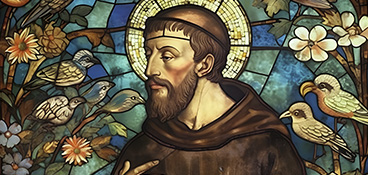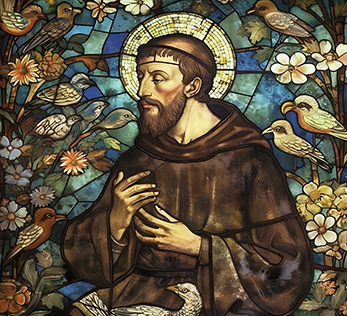St. Francis of Assisi
St. Francis is the patron saint of animals and ecology
St. Francis’ feast day is October 4

The Order of Friars Minor (OFM), commonly known as Franciscans, originated from St. Francis of Assisi.
The story of St. Francis of Assisi
Francis was born in Assisi, Italy in 1181/1182 to a wealthy cloth merchant. He lived a carefree youth before taking part in a war and even being held prisoner for a year. In 1205, he had a vision in which he was called to return to Assisi and await the call to a different type of knighthood. After several other visions and spiritual episodes, he converted to the apostolic life and committed himself to solitude and prayer.
St. Francis’ conversion
St. Francis was inspired to imitate Christ and literally carry out his work. He renounced material goods and family ties, embraced poverty, venerated the Eucharist, and preached that nature is the mirror of God. In 1224, on the mountain of La Verna, Francis received the stigmata – the wounds of the Lord’s passion on his own body.
What we can learn from St. Francis
St. Francis was known for his childlike joy and good humor – a freedom attributed to his unquestioning faith in the love of God the Father. St. Francis shows us that, by focusing on and enjoying the gifts and blessings God has given us, the heart can remain free of materialism to serve God above all else.
St. Francis inspires so many
Francis’ legacy is extensive, carried on through the countless people and organizations that he continues to inspire, and through the legacy of his writings.
- The Order of Friars Minor. In this fraternity, the friars follow Jesus Christ more closely under the inspiration of the Holy Spirit. Through profession of vows of poverty, chastity, and obedience, they dedicate themselves totally to God whom they love above all. They live the Gospel in the Church according to the form observed and proposed by St. Francis.
- Clare of Assisi, a contemporary of Francis, wanted to share Francis’ choice of life. She founded the Poor Ladies, which would later become known as the Poor Clares, a cloistered community of nuns.
- The Franciscan Third Order, now called the Secular Franciscan Order, was inspired by St. Francis.
- The Custody of the Holy Land grew out of a trip Francis took to Egypt in 1219-1220, while there was a crusade under way. During this trip, Francis met the Sultan. This meeting inspired the birth of the Custody, by which the Franciscan Order watches over and guards the holy places related to Jesus in Jerusalem.
The writings of St. Francis
One of St. Francis’ most well-known works is the Canticle of the Creatures, a poetic prayer that praises God the creator of everything and expresses respect for creation. The Canticle inspired the selection of October 4th, Francis’ feast day, as World Animal Day in 1925, and his proclamation by the Church as the patron saint of animals and ecology in 1979.
But perhaps what makes Francis so loved in every age is the way he prayed and taught others to pray. St. Francis experienced Jesus risen and living in our hearts. He teaches us that we can do the same if only we open our hearts and let Jesus in.
Important dates for St. Francis
Francis died in the overnight of October 3 – October 4, 1226, and his holiness and popularity led to his being canonized just two years later in 1228. In 1939, Pope Pius XII named Francis one of the patron saints of Italy. He is also the patron saint of animals and ecology. Francis’ Feast Day is celebrated on October 4.
How to pray to St. Francis
O beloved St. Francis,
You who lived in perfect humility and joy, reflecting God’s love in all creation, we come before you, seeking your intercession. Guide us on the path of peace, simplicity, and service to others, as you once walked in the light of Christ’s grace.
Together with you, we pray:
Most High, glorious God,
enlighten the darkness of our hearts,
and give us true faith, certain hope, and perfect charity.
Grant us sense and knowledge, Lord,
so that we may faithfully carry out Your holy and true command.
Through your intercession, may we grow closer to God and embrace His will with joyful hearts, always striving to be instruments of peace in the world.
Amen.
For daily inspiration from the Saints, follow our Facebook page.
Make an offering with a prayer intention to St. Francis
The Order of Friars Minor (OFM), commonly known as Franciscans, originated from St. Francis of Assisi.
The story of St. Francis of Assisi
Francis was born in Assisi, Italy in 1181/1182 to a wealthy cloth merchant. He lived a carefree youth before taking part in a war and even being held prisoner for a year. In 1205, he had a vision in which he was called to return to Assisi and await the call to a different type of knighthood. After several other visions and spiritual episodes, he converted to the apostolic life and committed himself to solitude and prayer.
St. Francis’ conversion
St. Francis was inspired to imitate Christ and literally carry out his work. He renounced material goods and family ties, embraced poverty, venerated the Eucharist, and preached that nature is the mirror of God. In 1224, on the mountain of La Verna, Francis received the stigmata – the wounds of the Lord’s passion on his own body.
What we can learn from St. Francis
St. Francis was known for his childlike joy and good humor – a freedom attributed to his unquestioning faith in the love of God the Father. St. Francis shows us that, by focusing on and enjoying the gifts and blessings God has given us, the heart can remain free of materialism to serve God above all else.
St. Francis inspires so many
Francis’ legacy is extensive, carried on through the countless people and organizations that he continues to inspire, and through the legacy of his writings.
- The Order of Friars Minor. In this fraternity, the friars follow Jesus Christ more closely under the inspiration of the Holy Spirit. Through profession of vows of poverty, chastity, and obedience, they dedicate themselves totally to God whom they love above all. They live the Gospel in the Church according to the form observed and proposed by St. Francis.
- Clare of Assisi, a contemporary of Francis, wanted to share Francis’ choice of life. She founded the Poor Ladies, which would later become known as the Poor Clares, a cloistered community of nuns.
- The Franciscan Third Order, now called the Secular Franciscan Order, was inspired by St. Francis.
- The Custody of the Holy Land grew out of a trip Francis took to Egypt in 1219-1220, while there was a crusade under way. During this trip, Francis met the Sultan. This meeting inspired the birth of the Custody, by which the Franciscan Order watches over and guards the holy places related to Jesus in Jerusalem.
The writings of St. Francis
One of St. Francis’ most well-known works is the Canticle of the Creatures, a poetic prayer that praises God the creator of everything and expresses respect for creation. The Canticle inspired the selection of October 4th, Francis’ feast day, as World Animal Day in 1925, and his proclamation by the Church as the patron saint of animals and ecology in 1979.
But perhaps what makes Francis so loved in every age is the way he prayed and taught others to pray. St. Francis experienced Jesus risen and living in our hearts. He teaches us that we can do the same if only we open our hearts and let Jesus in.
Important dates for St. Francis
Francis died in the overnight of October 3 – October 4, 1226, and his holiness and popularity led to his being canonized just two years later in 1228. In 1939, Pope Pius XII named Francis one of the patron saints of Italy. He is also the patron saint of animals and ecology. Francis’ Feast Day is celebrated on October 4.
How to pray to St. Francis
O beloved St. Francis,
You who lived in perfect humility and joy, reflecting God’s love in all creation, we come before you, seeking your intercession. Guide us on the path of peace, simplicity, and service to others, as you once walked in the light of Christ’s grace.
Together with you, we pray:
Most High, glorious God,
enlighten the darkness of our hearts,
and give us true faith, certain hope, and perfect charity.
Grant us sense and knowledge, Lord,
so that we may faithfully carry out Your holy and true command.
Through your intercession, may we grow closer to God and embrace His will with joyful hearts, always striving to be instruments of peace in the world.
Amen.
For daily inspiration from the Saints, follow our Facebook page.










